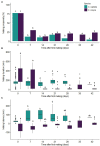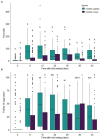Patterns of Remating Behaviour in Ceratitis (Diptera: Tephritidae) Species of Varying Lifespan
- PMID: 35197865
- PMCID: PMC8859485
- DOI: 10.3389/fphys.2022.824768
Patterns of Remating Behaviour in Ceratitis (Diptera: Tephritidae) Species of Varying Lifespan
Abstract
Trade-offs between life-history traits offset the energetic costs of maintaining fitness in complex environments. Ceratitis species have been recorded to have long lifespans, which may have evolved in response to seasonal resource fluctuation. It is thus likely that reproductive patterns have evolved concomitantly as part of the trade-off between lifespan and reproduction. In this study, we investigated how reproductive patterns differ between Ceratitis cosyra (Walker) and Ceratitis capitata (Wiedemann; Diptera: Tephritidae), two species with different average and maximum lifespans. Females of both species were mated and patterns of female survival, fecundity, remating and sperm storage were tested. Ceratitis cosyra had a higher rate of survival and a lower fecundity when compared with the shorter-lived C. capitata, suggesting that both species exhibit a trade-off between lifespan and reproduction. Both species showed a similar and consistent willingness to remate, despite declines in sperm storage, suggesting that sperm alone does not fully inhibit remating. As expected, C. cosyra transferred high numbers of sperm during the first mating. However, sperm stores declined unexpectedly by 14 days. This indicates that males might transfer large ejaculates as a nuptial gift, that females then later degrade as a source of nutrients. Large declines in sperm storage may also indicate that females discard excess sperm stores due to the toxicity involved with storing sperm. These results do not suggest that patterns of sperm storage and remating align with lifespan and resource seasonality in these species, but a wider range of species needs to be assessed to better understand variation in Ceratitis mating systems.
Keywords: Tephritidae; lifespan; reproduction; sperm storage; trade-off.
Copyright © 2022 Pogue, Malod and Weldon.
Conflict of interest statement
The authors declare that the research was conducted in the absence of any commercial or financial relationships that could be construed as a potential conflict of interest.
Figures




Similar articles
-
Oxidative Damage Is Influenced by Diet But Unaffected by Selection for Early Age of Oviposition in the Marula Fly, Ceratitis cosyra (Diptera: Tephritidae).Front Physiol. 2022 Feb 28;13:794979. doi: 10.3389/fphys.2022.794979. eCollection 2022. Front Physiol. 2022. PMID: 35295580 Free PMC article.
-
Selection on age of female reproduction in the marula fruit fly, Ceratitis cosyra (Walker) (Diptera: Tephritidae), decreases total antioxidant capacity and lipid peroxidation.J Insect Physiol. 2020 Aug-Sep;125:104084. doi: 10.1016/j.jinsphys.2020.104084. Epub 2020 Jul 4. J Insect Physiol. 2020. PMID: 32634434
-
Efficacy of an existing Ceratitis capitata (Diptera: Tephritidae) cold disinfestation treatment schedule for Ceratitis cosyra.J Econ Entomol. 2023 Jun 13;116(3):779-789. doi: 10.1093/jee/toad063. J Econ Entomol. 2023. PMID: 37030002
-
Interactions of mating, egg production and death rates in females of the Mediterranean fruit fly, Ceratitis capitata.Proc Biol Sci. 1998 Oct 7;265(1408):1879-94. doi: 10.1098/rspb.1998.0516. Proc Biol Sci. 1998. PMID: 9802244 Free PMC article. Review.
-
Selection on female remating interval is influenced by male sperm competition strategies and ejaculate characteristics.Philos Trans R Soc Lond B Biol Sci. 2013 Jan 21;368(1613):20120044. doi: 10.1098/rstb.2012.0044. Print 2013 Mar 5. Philos Trans R Soc Lond B Biol Sci. 2013. PMID: 23339235 Free PMC article. Review.
Cited by
-
Selection on female reproductive schedules in the marula fly, Ceratitis cosyra (Diptera: Tephritidae) affects dietary optima for female reproductive traits but not lifespan.Front Insect Sci. 2023 May 17;3:1166753. doi: 10.3389/finsc.2023.1166753. eCollection 2023. Front Insect Sci. 2023. PMID: 38469485 Free PMC article.
-
On the impact of re-mating and residual fertility on the Sterile Insect Technique efficacy: Case study with the medfly, Ceratitis capitata.PLoS Comput Biol. 2024 May 6;20(5):e1012052. doi: 10.1371/journal.pcbi.1012052. eCollection 2024 May. PLoS Comput Biol. 2024. PMID: 38709817 Free PMC article.
-
Effects of Physiological Status and Environmental Factors on the Lure Responses of Three Pest Fruit Fly Species (Diptera: Tephritidae).J Chem Ecol. 2024 Nov;50(11):679-700. doi: 10.1007/s10886-024-01516-8. Epub 2024 Jul 8. J Chem Ecol. 2024. PMID: 38976098 Free PMC article.
-
Evaluating the Efficacy of the Male Annihilation Technique in Managing Oriental Fruit Fly (Diptera: Tephritidae) Populations through Microscopic Assessment of Female Spermathecae.Insects. 2024 Oct 14;15(10):796. doi: 10.3390/insects15100796. Insects. 2024. PMID: 39452372 Free PMC article.
References
-
- Aluja M., Jácome I., Macías-Ordóñez R. (2001). Effect of adult nutrition on male sexual performance in four Neotropical fruit fly species of the genus Anastrepha (Diptera: Tephritidae). J. Insect Behav. 14, 759–775. doi: 10.1023/A:1013037400676 - DOI
-
- Arita L. H. (1982). Reproductive and sexual maturity of the Mediterranean fruit fly, Ceratitis capitata (Weidemann) [Hawaii]. Proc. Hawaiian Entomol. Soc. 24, 25–29.
LinkOut - more resources
Full Text Sources
Research Materials

